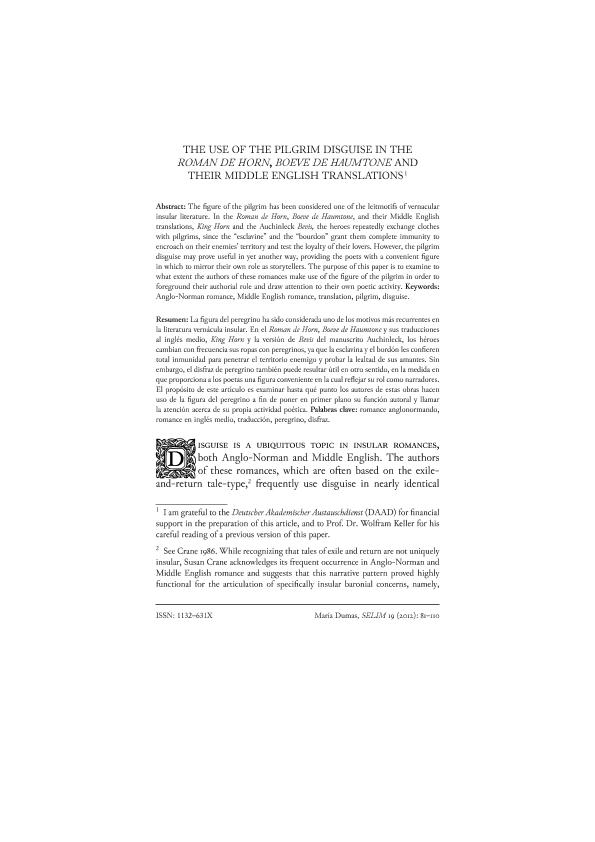Mostrar el registro sencillo del ítem
dc.contributor.author
Dumas, María

dc.date.available
2023-01-05T12:08:41Z
dc.date.issued
2012-07
dc.identifier.citation
Dumas, María; The use of the pilgrim disguise in the Roman de Horn, Boeve de Haumtone and their Middle English Translations; Sociedad Española de Lengua y Literatura Inglesa Medieval; SELIM; 19; 7-2012; 81-110
dc.identifier.issn
1132-631X
dc.identifier.uri
http://hdl.handle.net/11336/183470
dc.description.abstract
The figure of the pilgrim has been considered one of the leitmotifs of vernacular insular literature. In the Roman de Horn, Boeve de Haumtone, and their Middle English translations, King Horn and the Auchinleck Bevis, the heroes repeatedly exchange clothes with pilgrims, since the "esclavine" and the "bourdon" grant them complete immunity to encroach on their enemies´ territory and test the loyalty of their lover. However, the pilgrim disguise may prove useful in yet another way, providing the poets with a convenient figure in which to mirror their own role as storytellers. The purpose of this paper is to examine to what extent the authors of these romances make use of the figure of the pilgrim in order to foreground their authorial role and draw attention to their own poetic activity.
dc.description.abstract
La figura del peregrino ha sido considerada uno de los motivos más recurrentes en la literatura vernácula insular. En el Roman de Horn, Boeve de Haumtone y sus traducciones al inglés medio, King Horn y la versión de Bevis del manuscrito Auchinleck, los héroes cambian con frecuencia sus ropas con peregrinos, ya que la esclavina y el bordón les confieren total inmunidad para penetrar el territorio enemigo y probar la lealtad de sus amantes. Sin embargo, el disfraz de peregrino también puede resultar útil en otro sentido, en la medida en que proporciona a los poetas una figura conveniente en la cual reflejar su rol como narradores. El propósito de este artículo es examinar hasta qué punto los autores de estas obras hacen uso de la figura del peregrino a fin de poner en primer plano su función autoral y llamar la atención acerca de su propia actividad poética
dc.format
application/pdf
dc.language.iso
eng
dc.publisher
Sociedad Española de Lengua y Literatura Inglesa Medieval
dc.rights
info:eu-repo/semantics/openAccess
dc.rights.uri
https://creativecommons.org/licenses/by-nc-sa/2.5/ar/
dc.subject
ANGLO-NORMAN ROMANCE
dc.subject
MIDDLE ENGLISH ROMANCE
dc.subject
TRANSLATION
dc.subject
AUTHOR
dc.subject.classification
Literaturas Específicas

dc.subject.classification
Lengua y Literatura

dc.subject.classification
HUMANIDADES

dc.title
The use of the pilgrim disguise in the Roman de Horn, Boeve de Haumtone and their Middle English Translations
dc.type
info:eu-repo/semantics/article
dc.type
info:ar-repo/semantics/artículo
dc.type
info:eu-repo/semantics/publishedVersion
dc.date.updated
2023-01-03T14:39:28Z
dc.identifier.eissn
2792-3878
dc.journal.volume
19
dc.journal.pagination
81-110
dc.journal.pais
España

dc.journal.ciudad
Oviedo
dc.description.fil
Fil: Dumas, María. Consejo Nacional de Investigaciones Científicas y Técnicas. Oficina de Coordinación Administrativa Saavedra 15. Instituto Multidisciplinario de Historia y Ciencias Humanas; Argentina. Universidad de Buenos Aires. Facultad de Filosofía y Letras. Departamento de Letras; Argentina
dc.journal.title
SELIM
dc.relation.alternativeid
info:eu-repo/semantics/altIdentifier/url/https://reunido.uniovi.es/index.php/SELIM/article/view/13343
dc.relation.alternativeid
info:eu-repo/semantics/altIdentifier/url/https://dialnet.unirioja.es/servlet/articulo?codigo=4965901
Archivos asociados
